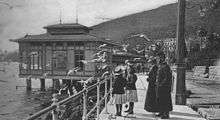Austrian Riviera
The Austrian Riviera (German Österreichische Riviera, Italian Riviera Austriaca, Slovene Avstrijska riviera, Croatian Austrijska rivijera) is a description for the coastal strip of former Austrian Littoral, a Habsburg crown land which until 1919 stretched along the northeastern Adriatic Coast.
The Austrian Riviera covered coastal areas adjacent the port city of Trieste. The Istrian coast south of Trieste is now part of the Italian municipality of Muggia (Slovene Milje), the Coastal-Karst of Slovenia, and the County of Istria in Croatia. The coast north of Trieste is partially rocky, and partially sandy, with the Laguna di Grado. It is now part of the autonomous Friuli-Venezia Giulia region of Italy.
The coast presents a charming landscape and a year-round mild climate.
History



In Ancient Roman times the region was the site of important settlements like Aquileia.
During the Middle Ages and until 1797, most of the area was administrated by Venetian Republic. In 1382, Trieste was joined with the Habsburg Monarchy which also controlled most of the hinterland. Trieste developed into an important port and trade hub and by 1719 a free port was constituted and further developed as the Habsburg Austria's principal commercial port and shipbuilding center.
In 1815, after the Napoleonic Wars, the remaining coastal villages became part of the new Austrian Empire and the completion of the South railway (Vienna–Trieste) in 1857 not only helped to further develop trade between the two cities but also brought Viennese upper class society to the mild winters of the Littoral. Trieste developed into a buzzing cosmopolitan city visited by artists, musicians, poets and writers from all over the Austrian Empire (later Austria-Hungary) and the rest of Europe. The surrounding coastal towns and villages developed into favorite hot spots for the rich and famous.
In 1850, Lošinj (Italian Lussino, German Lötzing) became a summer residence of the Habsburg Imperial family, and in 1860 Miramare Castle was completed for Archduke Maximilian.
In 1883, the beach resort on Brijuni Islands (Italian Brioni) was set up, and in 1904 the Austrian Riviera Journal (Österreichische Riviera Zeitung) was first published in Pula (Italian, German Pola).
Resorts:
- Grado (Slovene Gradež)
- Duino (Devin)
- Sistiana (Sesljan)
- Muggia (Milje)
- Portorož (Italian Portorose)
- Poreč (Parenzo)
- Rovinj (Rovigno)
- Opatija (Abbazia)
- Lovran (Laurana)
- Mali Lošinj (Lussinpiccolo)
Several luxury hotels were built during this era, like Hotel Kvarner in Opatija (1884) and Hotel Palace in Portorož (1910).
Eastern shore of Kvarner Gulf was then under administration of Hungarian part of Austria-Hungary with additional resorts developing, like Kraljevica (Italian: Porto Re), Crikvenica and Novi Vinodolski.
After World War I
In 1919 after World War I the Austrian Riviera became part of Italy and was cut off from most of its hinterland. During the 1920s, the Riviera flourished somewhat as a "Austro-Italian Riviera", but the splendor of its heyday was gone. The French Riviera and Italian Riviera in the western Mediterranean became more favorable resorts.
In 1947 Trieste, together with a small stretch of the adjacent coast became an independent Free Territory of Trieste. However, in 1954, the Free Territory was abolished, its territory split between Italy and Yugoslavia. Trieste, Grado, Sistiana and Muggia remained part of Italy.
Other
After the political closure of most of the Adriatic Coast in 1945 due to the Cold War, the State of Carinthia in Austria began to call its Wörthersee lake district the "Austrian Riviera."
See also
- Austrian Littoral
- Venezia Giulia
- Istria
- Riviera, featuring links to articles on the many coastal strips around the world which are known as Riviera